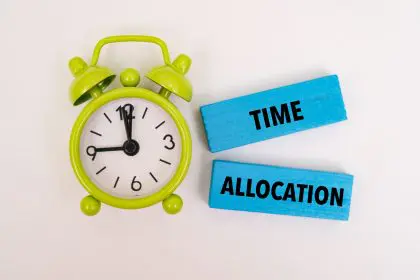Before diving into timelines and work-back plans, the first step is defining your life goals clearly. These can be anything from career milestones to health and fitness objectives, or even personal development aims like learning a new skill or improving relationships.
Take a moment to reflect on what truly matters to you. What is your ideal future? Identifying your “why” provides motivation and a sense of purpose. Once you’ve nailed down your goals, you can start outlining the steps to get there.
Without a timeline or work-back plan, even well-defined goals can seem overwhelming. You may be excited initially but face challenges along the way that could lead to procrastination or burnout. This is where a structured approach to goal-setting becomes invaluable.
The power of a timeline
When it comes to achieving anything in life, a timeline is a powerful tool. By setting specific deadlines for each phase of your goal, you give yourself clear checkpoints and milestones to aim for. Imagine embarking on a journey without a map; this is what pursuing life goals without a timeline feels like — uncertain, unstructured and often discouraging.
Creating a timeline not only gives your goals structure but also promotes a sense of urgency. It becomes a commitment to yourself that you will actively work toward your aspirations instead of just wishing for things to fall into place. A timeline helps you stay motivated because every deadline you meet, no matter how small, brings you closer to your final objective.
For example, if one of your life goals is to start a business, your timeline might include steps like researching your market in three months, developing a business plan within six months, securing funding in nine months, and officially launching within a year. Each milestone offers a clear target, helping you measure progress and stay on track.
Understanding the work-back plan
A work-back plan is the strategic partner of a timeline. While a timeline lays out when you will achieve certain milestones, a work-back plan focuses on how to accomplish these milestones. Essentially, it’s the roadmap that outlines the steps you need to take, starting from the final goal and working backward to the present.
One of the most effective aspects of a work-back plan is that it allows you to break down large, seemingly unattainable goals into manageable, actionable tasks. It’s like a recipe for success where each step builds on the previous one, ensuring that by the time you reach the final goal, everything is already in place.
For example, let’s say your life goal is to write a book in one year. Your timeline might look like this: researching your topic in the first two months, writing an outline by month three, completing the first draft within six months, and editing and refining over the remaining months. Using a work-back plan, you can break down each phase. For instance, during your “writing an outline” phase, your work-back plan might involve steps like brainstorming ideas, determining chapter breakdowns and setting daily writing goals.
Benefits of combining a timeline and work-back plan
Better time management: Knowing exactly what needs to be done and by when allows you to allocate your time more effectively. Instead of juggling all the components of your goal at once, you focus on one step at a time, making progress consistently without feeling overwhelmed.
Increased accountability and motivation: Breaking your goals down into smaller, actionable tasks provides natural checkpoints to measure your progress. It also makes it easier to hold yourself accountable, as you have clearly defined tasks and deadlines. Checking items off your work-back plan feels rewarding, and this progress motivates you to continue moving forward.
Flexibility to adjust plans: Life is unpredictable, and circumstances often change. A timeline and work-back plan offer flexibility by allowing you to adjust your approach without losing sight of the end goal. This adaptability makes it easier to stay committed to your goals despite life’s curveballs.
Avoiding procrastination: Having a structured timeline and detailed plan makes it harder to procrastinate. Without specific tasks and deadlines, it’s easy to put off actions until “later.” But with a work-back plan, you’re setting clear, short-term targets that keep you moving consistently toward your goal.
Creating a timeline and work-back plan
- Identify your final goal: Start by clearly defining what you want to achieve. Be specific about the outcome and visualize the end result.
- Break down the milestones: Work backward from your final goal to identify the significant milestones you need to hit along the way. Set realistic deadlines for each phase to keep the momentum going.
- Break milestones into smaller tasks: Each milestone on your timeline should be broken down into smaller tasks. For instance, if your milestone is to get physically fit in six months, break it down into weekly workout goals, meal planning and monthly fitness assessments.
- Allocate time and resources: Determine how much time and resources each task will require. This will help you stay organized and prepared for every step.
- Track progress and adjust: Regularly track your progress and adjust your timeline and work-back plan as needed. Celebrate the small wins, and use setbacks as learning opportunities.
The risk of drift
Life goals without a timeline or work-back plan often lead to what is known as “drift.” You may start off excited and motivated, but without structure, it’s easy to lose direction or become overwhelmed. Over time, this can lead to self-doubt, frustration and an unfulfilled sense of purpose. A timeline and work-back plan act like guardrails on your journey, guiding you toward your destination even when obstacles arise.
Crafting your path to success
Developing a timeline and work-back plan for your life goals is more than just organizing tasks; it’s about taking control of your life and intentionally moving towards your dreams. By defining clear steps, setting deadlines and working backward to break down each milestone, you transform your goals from distant dreams into attainable realities.
Setting goals is just the beginning, but having a detailed plan to get there is what separates dreamers from achievers. With a well-crafted timeline and work-back plan, you can approach any life goal with confidence, direction and a sense of purpose that will lead you to your desired outcome.
This story was created using AI technology.











